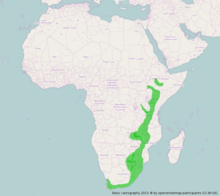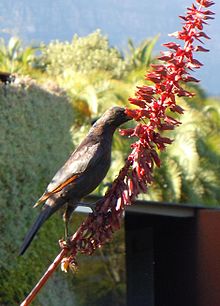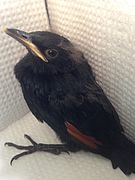
The mosque swallow is a large swallow. It is a resident breeder in much of sub-Saharan Africa, although most common in the west. It does not migrate but follows the rains to some extent.
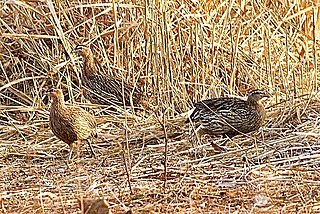
The double-spurred spurfowl is a gamebird in the pheasant family Phasianidae of the order Galliformes, gallinaceous birds. Like most spurfowls, it is restricted to Africa. It is a resident breeder in tropical west Africa, but there is a small and declining isolated population in Morocco.

The black-crowned tchagra is a bushshrike. This family of passerine birds is closely related to the true shrikes in the family Laniidae, and was once included in that group.

The Senegal coucal is a member of the cuckoo order of birds, the Cuculiformes, which also includes the roadrunners, the anis, and the hoatzin. It is a medium-sized member of its genus and is found in lightly-wooded country and savannah in central and southern Africa.

The yellow-billed oxpecker is a passerine bird in the family Buphagidae. It was previously placed in the starling and myna family, Sturnidae.
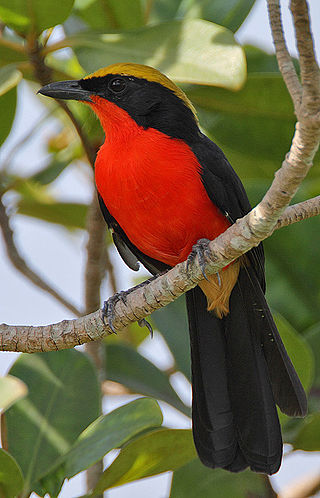
The yellow-crowned gonolek, also known as the common gonolek, is a medium-sized passerine bird in the bushshrike family. It is a common resident breeding bird in equatorial Africa from Senegal and Democratic Republic of Congo east to Ethiopia. It is a skulking bird and frequents dense undergrowth in forests and other wooded habitats. The nest is a cup structure in a bush or tree in which two eggs are laid.

The red-cheeked cordon-bleu or red-cheeked cordonbleu is a small passerine bird in the family Estrildidae. This estrildid finch is a resident breeding bird in drier regions of tropical Sub-Saharan Africa. Red-cheeked cordon-bleu has an estimated global extent of occurrence of 7,700,000 km2.

The red-billed firefinch or Senegal firefinch is a small seed-eating bird in the family Estrildidae. This is a resident breeding bird in most of Sub-Saharan Africa with an estimated global extent of occurrence of 10,000,000 km2. It was introduced to Egypt, but the population there has become extinct. It was also introduced to southern Algeria where it is currently expanding northward.

The Cape weaver is a species of bird in the weaver family, Ploceidae, found in southern Africa.

The yellow bishop, also known as Cape bishop, Cape widow or yellow-rumped widow, is a resident breeding bird species in Angola, Botswana, Burundi, Cameroon, Congo, Equatorial Guinea, Eswatini, Ethiopia, Kenya, Lesotho, Malawi, Mozambique, Nigeria, Rwanda, South Africa, South Sudan, Tanzania, Uganda, Zambia and Zimbabwe.

The Cape bunting is a passerine bird in the bunting family Emberizidae.
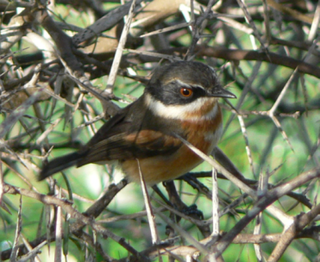
The Cape batis is a small, stout insect-eating passerine bird in the wattle-eye family. It is endemic to the Afromontane forests of southern Africa.

The Cape wagtail, also known as Wells's wagtail, is a small insectivorous bird which is widespread in southern Africa. It frequents water's edge, lawns and gardens. It is a mostly resident, territorial species, but has been known to undertake limited altitudinal migration or form flocks outside of the breeding season. Like other wagtails they are passerine birds of the family Motacillidae, which also includes the pipits and longclaws.

The Cape bulbul is a member of the bulbul family of passerine birds. It is an endemic resident breeder in coastal bush, open forest, gardens and fynbos in western and southern South Africa. This species nests mainly in the southern spring from September to November. The nest is a thick-walled cup concealed by foliage in a small tree or shrub.

The brimstone canary or bully canary is a small passerine bird in the finch family. It is a resident breeder in central and southern Africa.
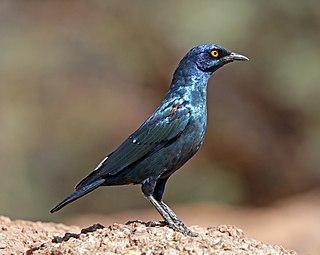
The Cape starling, also known as red-shouldered glossy-starling or Cape glossy starling, is a species of starling in the family Sturnidae. It is found in Southern Africa, where it lives in woodlands, bushveld and in suburbs.

Onychognathus is a genus of starlings, most of which are found in Africa.

The coleto is a starling species in the monotypic genus Sarcops. It is endemic to the Philippines. Its natural habitats are subtropical or tropical dry forest, subtropical or tropical moist lowland forest, and subtropical or tropical moist montane forest. In Filipino and Tagalog, this bird is known as kuling or koleto, while in Central Visayas, it is commonly known as the sal-ing.

The blue-spotted wood dove or blue-spotted dove is a species of bird in the family Columbidae. It is abundantly present throughout Africa south of the Sahel; it is partially present in East Africa and absent in southern Africa.

The scarlet-chested sunbird is a species of bird in the family Nectariniidae. It is found in many areas of Sub-Saharan Africa, and from South Sudan to South Africa.

